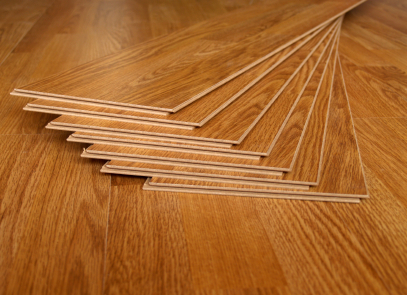The following DIY article on how to install laminate flooring was written by a contractor friend of ours. Follow the directions closely and you should have a beautiful new laminate floor in your home in no time!

Installing laminate flooring begins with having, buying or renting the tools necessary for doing the complete job. Tools that you will need include a hand saw, utility knife, measuring tape, tapping block, miter saw, hammer, spacers, pry bar, and vapor barrier paper. If you have all of these tools / materials, the job will be easy and take no time at all. Laminate flooring is perfect for rooms with high traffic or low traffic. The laminate that is available today is durable and comes in different wood grains and colors. Some people choose to leave the old flooring down and install on top of the old. This is fine if the old flooring is the roll out plastic or vinyl style. Hard wood is often too expensive for some people and maintenance can be extensive. According to many, laminate wood floors look just as good when complete and are less expensive and easier to maintain. Solid wood floors may be difficult to install where laminate is easy for the homeowner to do as a DIY project.
Step One:
Use your measuring tape to measure the square footage of the room you are working. This will tell you how much laminate to purchase as well as vapor barrier paper. When measuring, make sure to remove any baseboards so you can measure edge to edge. Add in for closets and other small areas of the room.
Step Two:
When purchasing your laminate flooring, always add in 20-25% more in case of mistakes and areas you may have measured wrong. Sometimes laminate flooring may have a piece with a chip that you may not want to use. You may also want to purchase this extra in case of damage later that you want to replace or repair. Open the boxes and allow the flooring to sit for a couple of days to avoid buckling of the new laminate.
Step Three:
Remove all furniture, and baseboards from the room. Sweep the area and remove any dirt or trash that is on the floor. The crow bar may come in handy when removing molding from floors or up walls. Before you begin installing the flooring, make sure to go through the flooring to check for any pieces that may have damage.
Step Four:
Roll out vapor barrier on the section that you will be working on. The vapor barrier is plastic and foam. This should go on top of the sub floor. Use your utility knife to cut the paper. Smooth out all wrinkles in the barrier and pull up against the walls. Do not overlap foam because this may make the floor uneven.
Step Five:
Choose the wall that is most prominent. Begin laying the boards leaving 5/16th of an inch at the wall. This will allow for expanding and contracting of the floor during heat and cold. Applying a spacer between wood and floor will keep you consistent throughout the whole room. Begin with a groove side at the wall.
Step Six:
After the first board is set, apply one board after another by snapping the boards in place. Be careful not to press too hard or break the groove. A rubber mallet or you are tapping block and hammer will help push the pieces together tightly. Tap gently so that you do not break the edge of the board. Continue attaching boards together until you complete your first row. If the distance is too short to the wall, you may need to cut a board to fit. Leave the 5/16th for the spacer at the wall.
Step Seven:
Continue to add row after row by connecting tongue and groove. If you are looking for a scatter in the boards, begin by laying the next row at the wall you finished the first row. Continue this process until all boards are laying tightly and covering the whole floor. If any floor is angle cut, use the miter saw to cut the correct angle in the boards.
Step Eight:
After all of the boards are down, you can begin replacing all molding around the walls. Begin with one edge and work around the room. Make sure to get the correct pieces in the correct places before beginning to apply them. Remove spacers and add molding. Tack into place using tiny nails and hammer.
Step Nine:
Walk around the whole room and make sure all of the boards are together tightly. While inspecting boards for a snug fit, check to see if there are any chips or cracks in the boards. If there are cracks or spaces, you can repair these with colored caulk.
Step Ten:
Replace furniture and enjoy your new laminate flooring. Enjoy the pride that comes with knowing you did the installation yourself. Purchase a good broom to clean the floor.
There are different types of laminate flooring to choose. Some have wood grain like real hard wood floor; some have the stone or granite appearance. The laminate comes in a popular collection of colors and styles. They are very durable and easy to care for and clean. These floors do best in homes because they can take wear and tear more than original hard wood floors. Check out the many types of laminate online before making your final selection on the style you wish to put in your house. Laminate flooring has improved tremendously over the years.
Tags: laminate, molding, plastic flooring, sub-floor, vapor barrier, vinyl, wood
